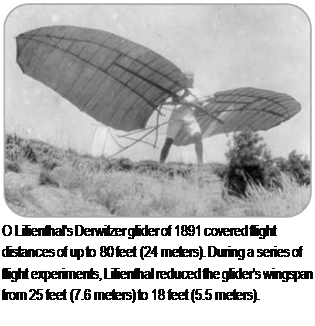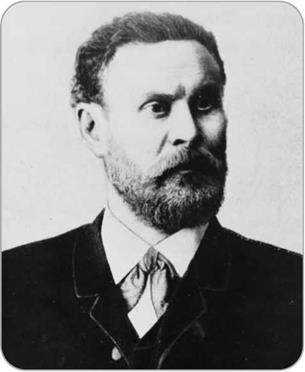Lilienthal, Otto
Date of birth: May 23, 1848.
Place of birth: Anklam, Germany.
Died: August 10, 1896.
Major contribution: Researched and wrote about many principles of aerodynamics and aeronautics; first person photographed flying a successful heavier-than-air aircraft.
|
O |
tto Lilienthal became attracted to the idea of flying as a teenager. In his first attempts at flying, he tried to mimic the method used by birds. Lilienthal built two pairs of 6.5-foot-long (1.9-meter-long) wings. He strapped one pair on his brother’s arms and the second pair on himself. The two ran down a hill flapping the wings, hoping to take off into the air. The experiment failed, but Lilienthal remained committed to flying.
In 1870, Lilienthal graduated with a degree in mechanical engineering from the University of Berlin, Germany. While heading a factory that made engines, he devoted his spare time to studying the flight of birds.
In 1891, Lilienthal built his first glider. The frame was made of willow wood covered by cotton fabric. The wings were 25 feet (7.6 meters) long from tip to tip. Lilienthal bounced off a springboard to launch himself into the air. On the first attempt, he traveled only a few feet. Lilienthal made repeated experiments, increasing the height of the springboard and then shortening the wingspan.
|
О The research work and experiments of Otto Lilienthal helped many early aviators, such as the Wright brothers, achieve advances in their own flying ventures. |
Eventually, he glided as far as 80 feet (24 meters).
Over the next few years, Lilienthal continued tinkering with gliders. From 1891 to 1896 he took more than 2,000 glider flights. Lilienthal tried covering both sides of the wings and adjusting wingspan. Most of his designs were monoplanes, with single wings, but some were biplanes. In most of his aircraft, Lilienthal stood in a harness between the wings, with his torso above the wings and his legs below. Once aloft, he maneuvered the glider by shifting his weight from one side to another or by leaning to the front or the back.
![]()
AN IMPORTANT PUBLICATION
 In 1889, Otto Lilienthal published a book summarizing his research into how birds fly. Called Bird Flight as the Basis of Aviation, it was a brilliant work for its time. Lilienthal concluded that the curved shape of birds’ wings was the secret to their flying ability. He proposed that a flat surface would offer less wind resistance and prevent lift. He also calculated how long wings would have to be to carry a human into flight.
In 1889, Otto Lilienthal published a book summarizing his research into how birds fly. Called Bird Flight as the Basis of Aviation, it was a brilliant work for its time. Lilienthal concluded that the curved shape of birds’ wings was the secret to their flying ability. He proposed that a flat surface would offer less wind resistance and prevent lift. He also calculated how long wings would have to be to carry a human into flight.
Although effective, the technique was difficult and required great strength. Lilienthal tried adding devices to make it easier to guide the glider.
By 1894, Lilienthal had decided that he needed a better launching area. He mounded dirt into a hill and built a shed on top, where he stored his equipment. The hill allowed Lilienthal to launch no matter which way the wind was blow – ing—he could simply run down the appropriate side of the hill. He always chose to run into the wind to get the needed lift.
Lilienthal was able to glide more than 150 feet (46 meters) from his new launching site, but he wanted to go even farther. As a result, he began launching himself from some higher hills near Berlin. On one trip, Lilienthal traveled 1,150 feet (350 meters).
Continued tests led to a fatal disaster. On August 9, 1896, Lilienthal took a glider flight in the midst of heavy wind gusts. One gust caught the glider and sent it crashing to the ground from 50 feet (15 meters) up. Lilienthal broke his back and died the next day.
Lilienthal’s work in aviation was of great importance. His writings influenced others interested in flying, including Orville and Wilbur Wright. Photographs taken of his glider flights inspired many early aviation pioneers by showing that a man could, indeed, build and fly a heavier-than-air aircraft.
——————————————– N
SEE ALSO:
• Aerodynamics • Aeronautics
• Aircraft Design • Glider • Lift
and Drag
_____________________________________________ )











